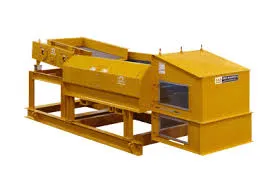
12 月 . 04, 2024 16:20 Back to list
The Principle of Hammer Mill
A hammer mill is a type of mechanical device widely used for grinding, crushing, and shredding various materials. It plays a crucial role in industries such as agriculture, food processing, pharmaceuticals, and recycling. Understanding the principle of a hammer mill is essential for optimizing its performance and efficiently processing materials.
At its core, a hammer mill operates on the principle of impact. The fundamental design includes a rotating shaft equipped with numerous swinging hammers or blades. These hammers are made of hard materials and are positioned in such a way that they can effectively strike the material being processed. When the motor drives the shaft to rotate, the hammers gain momentum and collide with the feed material, causing it to break or shatter.
The size of the particles is determined by several factors, including the rotating speed of the hammer mill, the size and shape of the hammers, and the screen size placed at the discharge area. The screen acts as a filter, allowing only those particles that are small enough to pass through, while retaining larger pieces for further grinding.

One of the key advantages of hammer mills is their versatility. They can process a wide range of materials, including grains like corn and wheat, fibrous materials such as straw and wood chips, and even harder substances like minerals. The ability to adjust the screen size allows operators to produce different particle sizes to meet specific requirements in various applications.
From a mechanical perspective, the design of the hammer mill also contributes to its efficiency. The centrifugal force generated by the rotation of the hammers aids in the continuous feeding of material into the mill. This ensures that the grinding process happens consistently, reducing the likelihood of material build-up and downtime. Moreover, since the crushing mechanism is based on impact rather than pressure, there is minimal heat generation, which helps preserve the quality of the processed material, especially in temperature-sensitive applications.
Another significant principle of the hammer mill is its ability to enhance particle surface area. By breaking down materials into smaller particles, the hammer mill increases the overall surface area exposed for subsequent processing steps, such as mixing or digestion. This is particularly important in feed production and biofuel generation, where the efficiency of the final product is closely linked to the size of the particles.
In conclusion, the principle of hammer mill revolves around the mechanism of impact, allowing for the efficient grinding and processing of a diverse range of materials. Its versatility, combined with mechanical efficiency and the ability to produce varying particle sizes, makes it an invaluable tool in several industrial applications. Understanding how a hammer mill works and the factors influencing its performance is essential for operators who aim to optimize production processes and achieve desired material characteristics. As industries continue to evolve, the application of hammer mills is likely to expand, making it imperative for professionals to stay informed about advancements in this technology.
Latest news
Unveiling the Power of Eddy Current Separator
NewsSep.25,2024
Transform Your Home Recyclin:home metal shredder
NewsSep.25,2024
The Future of Waste Management with Recycling Line Picker
NewsSep.25,2024
The Benefits of a Metal Recycling Plant
NewsSep.25,2024
Revolutionize Material Separation with Onwang Technology
NewsSep.25,2024
Innovative Waste Management: Unveiling the MSW Sorting Plant
NewsSep.25,2024